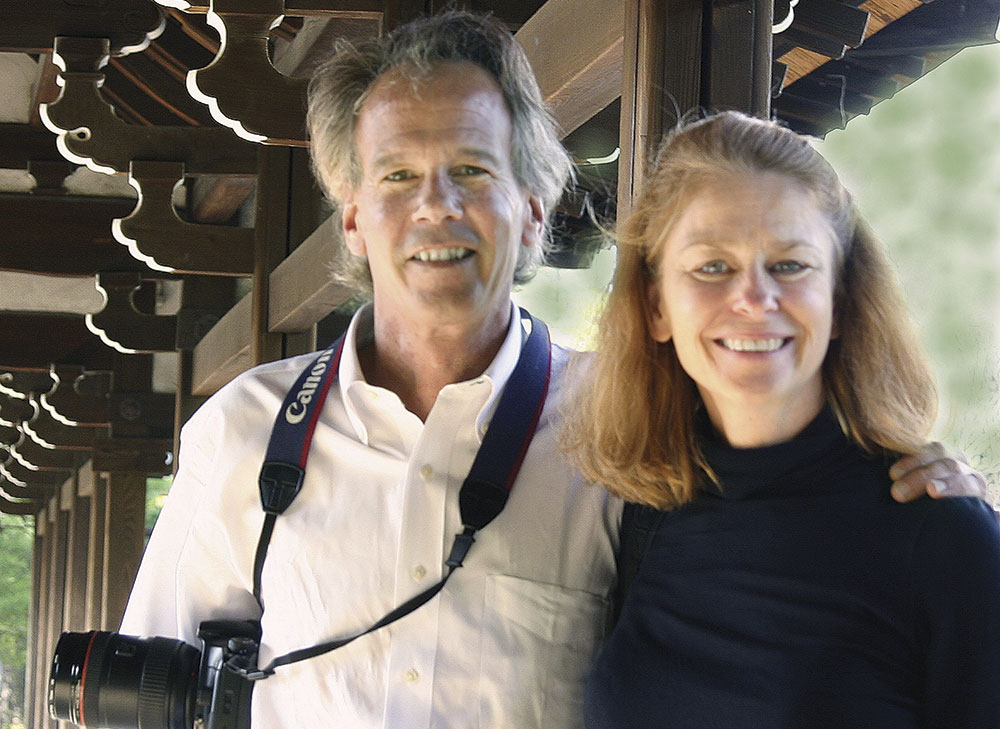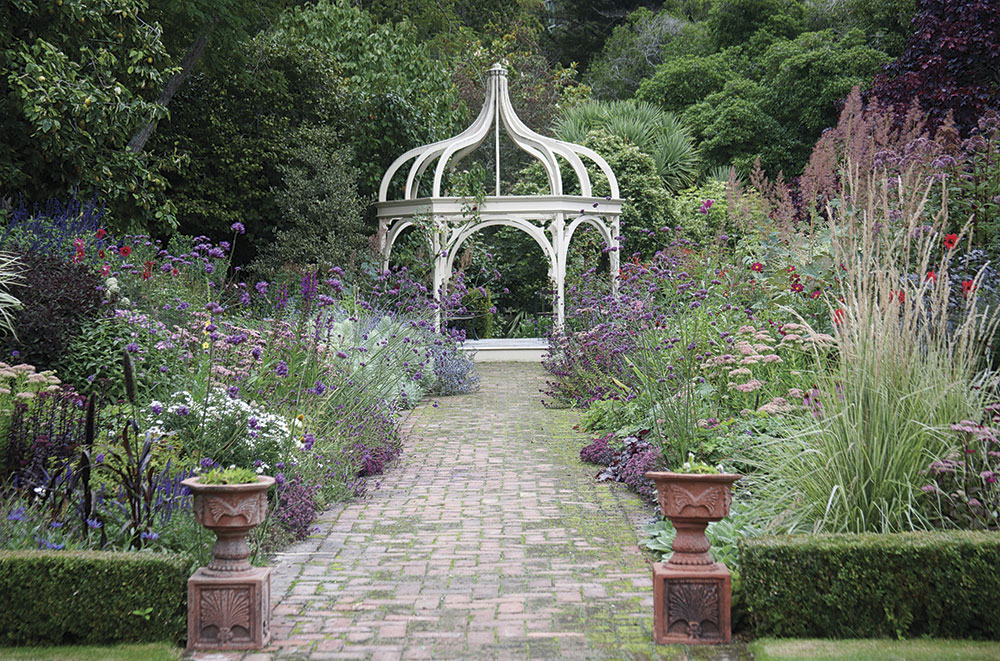
Virtuoso gardeners and husband/wife team Rose and Michael Bartlett worked together for 28 years, and in assembling the showpiece of their professional collaboration, The Bartlett Book of Garden Elements (Godine, 2014), they traveled to two-dozen countries and took 1,000 photos.
Six years ago, Rose moved to Asheville after Michael passed away, intent on finishing their book. Since then, she has opened her own business, Rose’s Garden Shop on Charlotte Street. Anticipating her talk at the Asheville Outdoor Living Expo, she spoke to Carolina Home + Garden about curating one’s flea-market finds, the challenges of topiary, and what’s in a name (her own, that is).
The introduction of non-botanical centerpieces in a garden suggests refinement — it’s where humans and horticultural meet, so to speak. Why is it important to pay attention to these kinds of garden elements?
I agree … garden elements often serve to highlight or enhance the intersection of nature or horticulture and architectural or sculptural [manmade] forms in the landscape. An arbor will support vines to encourage their healthy growth (a horticultural benefit) while serving an architectural purpose of framing a view, separating parts of a garden, or marking the entrance to a garden. Other garden elements, for instance stairs, have their origins in function but by imaginative use of materials and design they can become sculptural and enhance the overall appeal of a garden space. Garden elements are essentially design details and thoughtful, well-crafted details enhance any creative design.
You must have observed a lot of trends over the years. What’s big right now? Is a honey-bee hive or two a must for today’s socially conscious gardener?
The best examples of garden elements are timeless. However, they are often re-invented to represent the times, and that’s where the innovation is found. Right now, garden elements that encourage outdoor living and comfort are very popular. Garden furniture is an essential for outdoor living. Timeless cast-iron designs that were heavy and brittle are sometimes made of cast aluminum [today] … just watch out for windy locations! Teak has been over-harvested, so furniture designs now are more often made of sustainably farmed woods like shorea or acacia. A bonus is that these modern materials are often more affordable as well.
Today’s beehives are more functional than aesthetic. The primary goal is to maintain the health of the hive. Keeping bees is a commitment not to be taken lightly, since bees are easily susceptible to disease, parasites, and pesticides. If you do set up some hives, be sure to fence them for protection from marauding bears!
How many of the elements discussed in your book require professional installation? Are there any aspects of topiary, say, that the lay gardener might be able to learn on her own?
Elements like bridges, swimming pools, wiring and lighting, porches and decks are best installed by professionals. Other elements like arbors, gazebos, and pond liners can readily be founds as kits … if you have basic skills and you’re good at following instructions! Some elements only need to be placed … furniture, planters, small-scale sculpture.
Certain forms of topiary can be tackled by the lay gardener…simple geometric shapes would be easiest. Always aim to have all parts of the plant exposed to sunlight and prune at the right time of year for the species being trained. There are metal topiary forms available in a large variety of shapes from dogs to stars to flat frames (often called vertical gardens) that are stuffed with sphagnum moss and then planted with a wide assortment of plants such as succulents, annuals, and perennials.

Any thoughts on garden elements that are particularly suited to the vernacular of the region?
Garden elements that speak to the rustic atmosphere often work well … twig furniture and natural or locally produced natural materials. I have seen many beautiful walls made of regional stone and boulders. Ponds (even a very small one) can reflect our beautiful skies. Designs rooted in the Arts and Crafts style work well with that architectural style, which is locally abundant. There are a number of architectural styles found in the area, and reflecting upon the design of your house is a good idea.
The idea of enhancing one’s garden with a water feature is exciting, and landscape architects are getting ever-more creative and theatrical with them. What’s a good guideline for tailoring a water feature to the scope of one’s property, though? Are fountains best kept to urban gardens? Can waterfalls get too pretentious?
Water features should take into account the topography and size of the site. A small pond or even a container water garden can be tucked into most gardens and planted. Water enhances the garden by reflection and encourages birds to visit. Do be sure to use to use a biological control like Mosquito Dunks or Mosquito Bits to control the mosquitoes
A simple fountain or jet will add the soothing sound of water that might also mitigate unwanted sounds like traffic noise. Waterfalls can most definitely become pretentious when they are out of scale with the space. Great care must be taken that they are well-sited and artfully crafted to avoid looking unnatural.
What about vintage finds in furniture or statuary? Could a whole look be created out of such flea-market or garage-scale “scores” — and, if so, what sorts of plantings might complement this theme?
I’m a huge fan of vintage garden furniture and accessories. It’s a good idea to have some design consistency or philosophy when you scout out these “scores.” Are you aiming for a cottage look, a Victorian sensibility, Arts and Crafts design, mid-century modern …? A cottage-look plant scheme would be more informal with old-fashioned plants like hollyhocks, poppies, and roses. In the Victorian era, “bedding out” (controlled planting of colorful annuals) was the rage, while an Arts and Crafts palette would be restrained with more architectural form. But I think the bottom line is to have fun with your garden and experiment. Even the most seasoned gardeners make mistakes. Nevertheless, to increase your chance of success, it’s important understand your location in terms of light exposure, soil composition (the local extension agency can help with this), and the amount of follow-through maintenance you are able to provide.
You have a fortuitously beautiful name for what you do. Do you think your career might have taken a different turn had you been named something similar but less floral — say, Ruth or Rae?
I never liked my name as I was growing up. It was an old-fashioned name and not very cool. As I became an avid gardener it was almost too much to have a floral name … I had to be convinced by others to name my shop “Rose’s Garden Shop.” So in a way, my career developed despite my name, rather than because of it!
Rose Bartlett will be a featured speaker at the Asheville Outdoor Living Expo, appearing on April 23. See ashevilleoutdoorliving.com for details.
